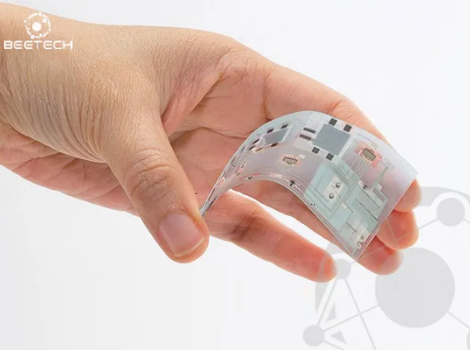80-82 Cao Duc Lan, District 2, HCMC, Vietnam
+84 76 865 6688
info@beetech.com.vn
+84 76 865 6688
About us
Contact us
80-82 Cao Duc Lan, District 2, HCMC, Vietnam
+84 76 865 6688
info@beetech.com.vn
+84 76 865 6688
About us
Contact us

What is NFC? What is RFID? What's the difference between NFC and RFID?
In today’s digital era, wireless identification technologies have become an essential part of everyday life and business operations. Two of the most popular technologies are RFID and NFC. Although NFC originates from RFID technology, they each have distinct features, advantages, disadvantages, and applications. This article will help you understand both technologies, their differences, and practical applications in modern life.

RFID (Radio Frequency Identification) is a technology that allows objects to be identified and data to be collected without direct contact. Data stored on an RFID tag is transmitted via radio waves to a reader, enabling the system to automatically and quickly identify items.
An RFID system consists of three main components: RFID tags, RFID readers, and data management software. RFID tags can be passive (no battery) or active (with battery). When a tag enters the reader’s signal range, the energy from the radio waves activates a passive tag, which then transmits data back to the reader. This process is fast and can read multiple tags simultaneously without manual intervention.
RFID is classified based on operating frequency:
Low Frequency (LF – 125–134 kHz): Short reading distance, commonly used for animal tracking or access control.
High Frequency (HF – 13.56 MHz): Medium reading distance, often used in payment cards and access cards.
Ultra High Frequency (UHF – 860–960 MHz): Can read from several meters up to tens of meters, suitable for warehousing, logistics, and supply chain management.
Advantages: No physical contact required, can read multiple tags simultaneously, stable in harsh environments, fast identification.
Disadvantages: High initial investment, especially for UHF RFID, susceptible to interference from metal and water, and lacks point-to-point (P2P) connectivity.
RFID is widely used in warehouse and logistics management to track goods and reduce loss, asset management such as equipment and machinery, production material tracking, and certain access control systems using LF or HF RFID.
NFC (Near Field Communication) is a wireless communication technology derived from HF RFID. NFC enables two devices to exchange data quickly within a very short range, typically under 10 cm. It is widely used in mobile payments, e-tickets, and quick device-to-device connectivity solutions.
NFC operates through electromagnetic induction at the HF frequency of 13.56 MHz. When two NFC devices come into proximity, the energy from the host device activates the second device, and data is exchanged according to communication standards. NFC can operate in three modes:
Read/Write mode: Read from or write data to an NFC tag.
Peer-to-Peer (P2P) mode: Allows direct data exchange between two devices.
Card emulation mode: The NFC device acts as a smart card, e.g., for mobile payments.
Advantages: Fast, simple, and secure communication; supports point-to-point (P2P) connectivity; ideal for mobile devices and smart cards; requires no complex setup.
Disadvantages: Short communication range (0–10 cm), lower data transfer speed compared to UHF RFID, cannot read from a long distance.
NFC is widely used in mobile payments such as Google Pay, Apple Pay, and Samsung Pay, e-tickets for buses, trains, and airports, access control in offices, hotels, and industrial zones, as well as quick data sharing between phones and other devices like images, contacts, and files.
Safer Communication: Short range reduces the risk of data theft.
Compatible with Existing Smart Cards: Easy integration with banking systems and e-tickets.
Quick and Automatic Connection: No complex setup, just close proximity required.
Supports Two-Way Data Exchange: Unlike RFID’s one-way data transfer, NFC allows peer-to-peer communication.
Longer range: UHF RFID can read tags from several meters to tens of meters.
Simultaneous multi-Tag reading: Improves efficiency in warehouse and logistics management.
Durable in harsh environments: LF/HF/UHF RFID can withstand heat, dust, and moisture better.
Flexible industrial applications: Asset management, goods tracking, supply chain control.
Both NFC and RFID are rapidly evolving due to increasing automation and contactless payment needs. RFID is applied in smart supply chains, automated warehouses, and IoT-integrated asset tracking in real-time. UHF RFID is even integrated into robots and drones for scanning goods. NFC has grown strongly in contactless payment solutions, especially post-COVID-19, integrated into smartphones, smartwatches, and wearable devices. NFC can also combine with QR codes and Bluetooth for enhanced connectivity and security.
RFID and NFC are both wireless data identification and transmission technologies, each with its own strengths and applications. RFID is optimal for warehouse management, logistics, manufacturing, and asset management, while NFC is suitable for payments, e-tickets, access cards, and quick device-to-device connectivity. Understanding the differences between the two helps businesses and individuals choose the right solution, improving operational efficiency and user experience. In the future, NFC and RFID will increasingly integrate with IoT, AI, and advanced security technologies, opening up smarter applications in life and business.
Let Beetech accompany you on your journey to apply NFC and RFID, building efficient, secure, and modern asset management, payment, and device connectivity systems.
Contact Beetech for free consultation:
📧 Email: info@beetech.com.vn
🌐 Website: https://beetech.com.vn

See more products: Here


What is NFC? What is RFID? What's the difference between NFC and RFID?
18/09/2025 02:55:49

RFID for Businesses: How to Implement an Effective Membership Card Program
17/09/2025 02:47:07

RFID Antennas – A Breakthrough Solution for Harsh Industrial Environments
08/09/2025 06:56:50

RFID: A modern management technology effectively replacing Barcodes
04/09/2025 03:21:00

Seamlessly Operating RFID Technology for Smart Manufacturing in Industry 4.0
19/08/2025 03:48:58

**RFID – A Breakthrough Solution for Modern Event Management in Vietnam**
28/07/2025 04:01:17